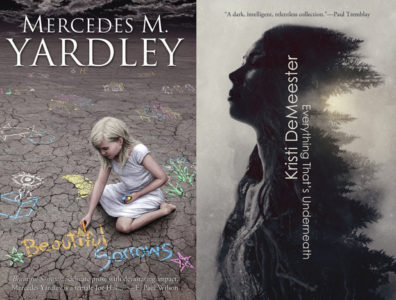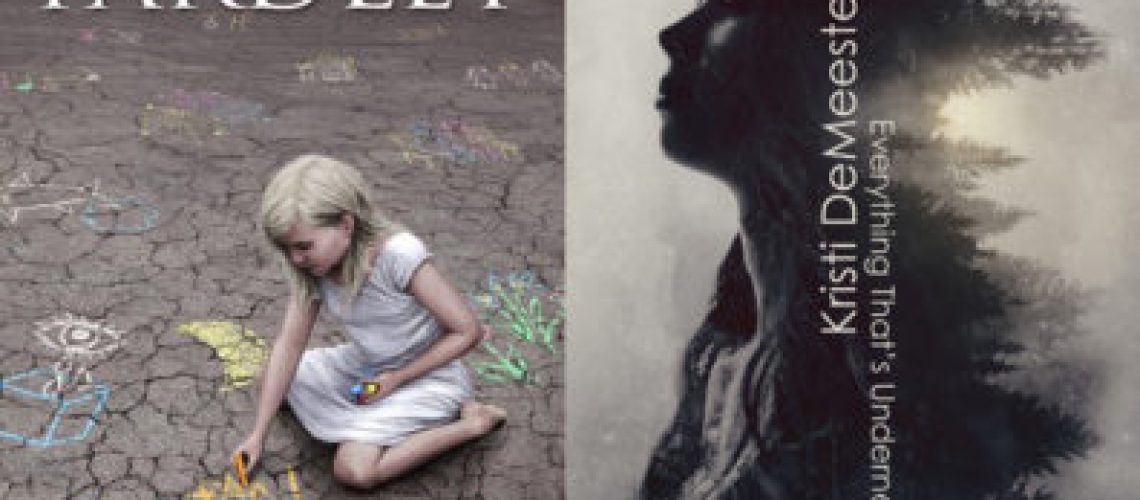Many of the reviewers associated with the Skiffy and Fanty team have a contribution specialty. I’ve always avoided this because I don’t like the limitations; I read/review outside of these genres even. But if I were to have a niche, it would probably be short fiction. I adore the variety it affords and the low commitment to discover new authors. It’s easier to convince myself to step away from work for a moment to read a short story, compared to equal time reading a portion of longer works that may not have obvious stopping points. Most importantly, some of the most exciting writing I’ve seen comes from the short form.
Two fabulous collections of short horror appeared last year from Apex Book Company. If you didn’t happen to catch note of them yet, then they are particularly worth considering now as we begin the ninth annual celebration of Women in Horror Month. Both Beautiful Sorrows by Mercedes M. Yardley and Everything That’s Underneath by Kristi DeMeester smolder with a joyful embrace, and defiance, of nightmares. As the titles in combination allude to, these two collections demonstrate that beneath fears lies terror and hope, beauty and monstrosity, sorrow and pleasure. A bit of everything festers underneath horror, full of contradictions in equal measure.

The poetic horror writer Stephanie M. Wytovich expresses this idea perfectly in her Goodreads review of Beautiful Sorrows (a longer, alternate review by her can be viewed here).
“… a bloody dandelion floating through the crisp autumn air, fueled by the whispers of little children. It’s a little bit of winter with a hint of twilight, and yet at the same time it shines with the beauty of spring and fresh orchids…”
Though released by Apex last year, Yardley’s collection actually debuted in 2012 from Shock Totem Publications, a small press recently acquired by Apex. It sets the mood with “Broken”, a flash fiction of only a few lines that is perfection. Many of the stories in Beautiful Sorrows would qualify as flash fiction, or ‘hint fiction’ as Yardley calls it. These indeed come off as almost fragmentary, as mere hints to some deeper story that isn’t appearing on the page. It is a testament to Yardley’s skill and confidence that she doesn’t try and turn these pieces into something more than they are. They succeed in their simplicity, in what imaginations and emotions are evoked in the reader without being laid out.
Many of Yardley’s stories start with effective hooks, from a lyrical turn of phrase to a bit of bizarre absurdity that makes you want to read more. Most don’t venture down any path of going surreal, however, but stick to the slightly fantastic side of realism to convey dark topics of humanity, particularly revolving around mortality and coming to terms with loss. While some could be clearly defined as horror, others would be better termed fantasy with a dark undercurrent, and at least one — the powerful “Big Bad Ben” — is conventional literature.
Everything That’s Underneath by DeMeester shares several qualities with Yardley’s collection, including the inclusion of some very short works and a strength at writing excellent opening lines that hook you in. The tone of the two collections and the authors’ approaches to horror also bear some similarity. The quote by Wytovich above only refers to Beautiful Sorrows, but to my mind Everything That’s Underneath by DeMeester evokes similar imagery of married contradiction and lyric beauty within nightmares.
DeMeester’s stories are more consistently within the horror and she overall embraces the unsettling aspects of a story or its characters. Some fit within distinct subgenres, such as the excellent, apocalyptic “The Wicked Shall Come Upon Him”, while retaining an overall horror vibe. DeMeester’s writing has been compared to Laird Barron, but Damien Angelica Walters (who provides a recommendation blurb for Everything That’s Underneath) is an even closer comparison. Several of her stories in this collection feature the theme of body horror, typically from a feminist perspective, and many also investigate the power and depths of mother-daughter relationships.
Our theme for Skiffy and Fanty last month was “Joy”, and for the remainder of the year is “Hope”. These foci weren’t born on their own, but rather as a reaction against the terror and sorrow-inducing horrors that dominated society and politics in 2017 (in the USA and globally). On its surface the emotions of joy and hope might not seem easily applicable to a genre like horror. The collections by Yardley and DeMeester each demonstrate that they are often inextricably linked to the stuff of nightmares.
Both Yardley and DeMeester are writing transformative horror from their own perspectives and emphases. Their stories deal with the ways in which the unsettling frissons and the agonizing pains of horror can be captured to transform into joy or power. Or how hope for something better, something more, can be found amid the worst horrors that might afflict us. Whether tackling this through symbolism of wings, stars, and heartbreak as Yardley frequently does, or through physical and cultural aspects of womanhood as DeMeester frequently does, their overall effects overlap. Both Beautiful Sorrows and Everthing That’s Underneath are exquisitely written, strong examples of what can be best about short fiction, and they deserve a wide audience from those that appreciate horror and dark fantasy.







